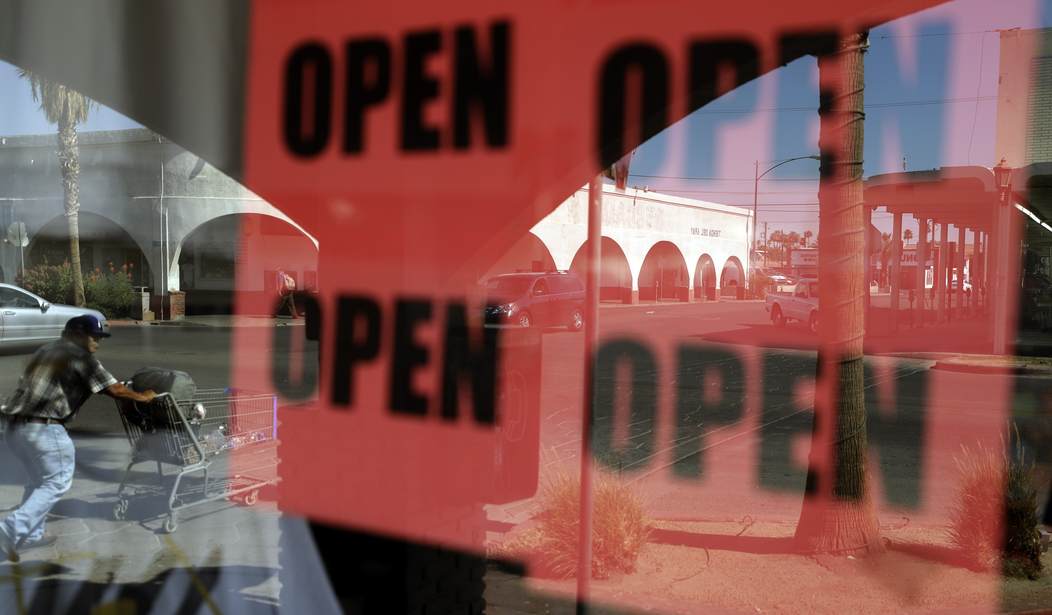A pleasant surprise, given the retail sales number in December. GDP growth in the fourth quarter hit 6.9%, its best reading in 2021, and the year-end advance estimate for growth came in at 5.7%. That’s the best annual growth since 1984’s explosive escape from recession, and business optimism appears to have provided most of the Q4 lift.
That’s a point to remember, but let’s first go over the good news, which is indeed adjusted for inflation:
Real gross domestic product (GDP) increased at an annual rate of 6.9 percent in the fourth quarter of 2021 (table 1), according to the “advance” estimate released by the Bureau of Economic Analysis. In the third quarter, real GDP increased 2.3 percent.
The GDP estimate released today is based on source data that are incomplete or subject to further revision by the source agency (refer to “Source Data for the Advance Estimate” on page 4). The “second” estimate for the fourth quarter, based on more complete data, will be released on February 24, 2022.
The increase in real GDP primarily reflected increases in private inventory investment, exports, personal consumption expenditures (PCE), and nonresidential fixed investment that were partly offset by decreases in both federal and state and local government spending. Imports, which are a subtraction in the calculation of GDP, increased (table 2).
“Real GDP” always includes adjustments for inflation (hence the “real” designation), so this shows actual economic growth. That’s good news, and the New York Times takes a sunny look at it:
The figure, which was adjusted for inflation, reflects the growth in gross domestic product — the broadest measure of the goods and services produced. On an annualized basis, the increase for the quarter was 6.9 percent.
For the full year, the economic expansion was the biggest since 1984 — an impressive feat, though one that also reflects the depth of the damage inflicted by the coronavirus the year before.
The acceleration in the fourth quarter was led by an upturn in exports as well as accelerations in inventory investment and consumer spending.
Consumer spending and private investment were quickly revived as a result of vaccination efforts, cheap credit conditions and additional rounds of federal aid to households and businesses. The labor market has recovered almost 19 million of the 22 million jobs lost near the peak of virus-induced suspensions in activity.
That might be a bit too sunny, however. Consumer spending wasn’t as “quickly revived” as one would think from the topline number, first off. After the first two quarters of the year produced double-digit increases in real personal consumption expenditures (PCEs), the last two quarters came in at a wan 2.0% and 3.3% growth rate. Overall PCEs increased 7.9%, but that came after two massive stimulus tranches in January and March-April, and was also a rebound from 2021’s -3.8% PCE change. For that matter, 2021’s overall GDP growth rate of 5.7% is based off a similar -3.4% GDP rate last year, which makes this more of a catch-up than a burst of fresh economic growth.
A much more worrisome sign comes in the final sales of domestic product for Q3 and Q4. In the third quarter, it only grew 0.1% while overall GDP went up 2.3%, both figures annualized. Despite a larger jump in overall GDP growth in Q4 to 6.9%, final sales — goods and services making it into the hands of end users in the US — only rose 1.9%. That does not portend an extended expansion, but instead looks more like inventory expansion and other business activity.
On that note, though, there was some unusually good news in two categories: business investments and exports. Gross private domestic investment increased by 12.4% in Q3 and almost tripled again in Q4 to 32%. That indicates significant investment in future growth, a sign that America’s executives are bullish on 2022. Furthermore, we had a great quarter on exports, which increased by 24.5% in Q4, outstripping a significant increase in imports (17.7%). That would be a big addition to the overall GDP number.
Of course, that kind of growth lets the Federal Reserve off the hook for any negative impacts from monetary-supply decisions, too. Guess what that will mean?
Facing both turbulent financial markets and raging inflation, the Federal Reserve on Wednesday indicated it could soon raise interest rates for the first time in more than three years as part of a broader tightening of historically easy monetary policy.
In a move that came as little surprise, the Fed’s policymaking group said a quarter-percentage point increase to its benchmark short-term borrowing rate is likely forthcoming. It would be the first rise since December 2018.
Chairman Jerome Powell added that the Fed could move on an aggressive path.
“I think there’s quite a bit of room to raise interest rates without threatening the labor market,” Powell said at his post-meeting news conference. After being up strongly earlier, the major stock market averages turned negative shortly following Powell’s pronouncement.
The Fed has little choice but to take action on inflation now. The longer they wait, the worse it will get and the harsher the countermeasures will have to be. For now, though, the GDP reports will give them some cover to argue that a moderate tightening won’t threaten the recovery … unless consumers keep their wallets closed.







Join the conversation as a VIP Member